A look at a New Orleans gallerist’s art-filled compound, on the cusp of donating his museum-worthy collection
By Mary Jo Bowling via nola.curbed.com
Photography by Paul Costello
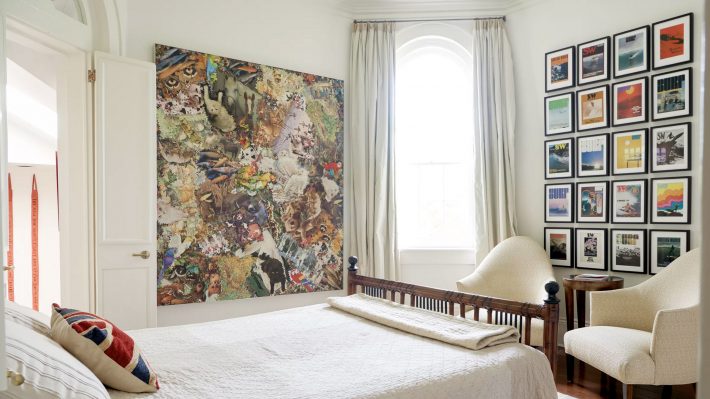
Arthur Roger likes people who live on the fringes, the areas that orbit dominant society. “It is where I’ve discovered the most, and it’s the place I’ve found most interesting,” he says.
The pull of the unconventional led him to purchase an unusual home in New Orleans’s French Quarter and amass a stunning collection of provocative art. And once he’d filled the walls with remarkable pieces, he gave them all away, leaving the white walls empty. This story looks at the moment just before that happened, capturing a snapshot from a lifetime of collecting.
Roger’s small compound includes an octagonal house (the only eight-sided dwelling in the French Quarter), a Creole Cottage, a garçonnière (a small replica of the main house, historically where sons went to live when they reached puberty), and a building he describes as former quarters for enslaved servants.
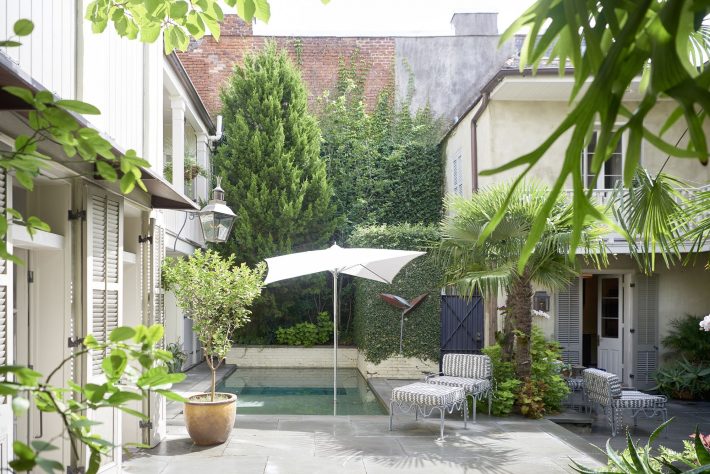
The main house (left) and former quarters for enslaved servants (right) surround a small courtyard.
Roger first experienced the place as a star-struck teenager. “While I was still in school, I worked as a framer, and I used to make deliveries here,” he says. “It was owned by two notorious guys, and I became enamored with the house. I call them notorious because they were talked about—they owned an amazing restaurant in town and they threw a lot of parties here. They were gay, and I had just come out—I admired them.”
Roger, a New Orleans native, went on to open his own modern art gallery—the Arthur Roger Gallery. Later, he left town to open a second gallery in New York City. Although he describes his years in New York as “the most exciting of my life,” he felt that he must return to New Orleans; and when he did, the house was waiting for him.
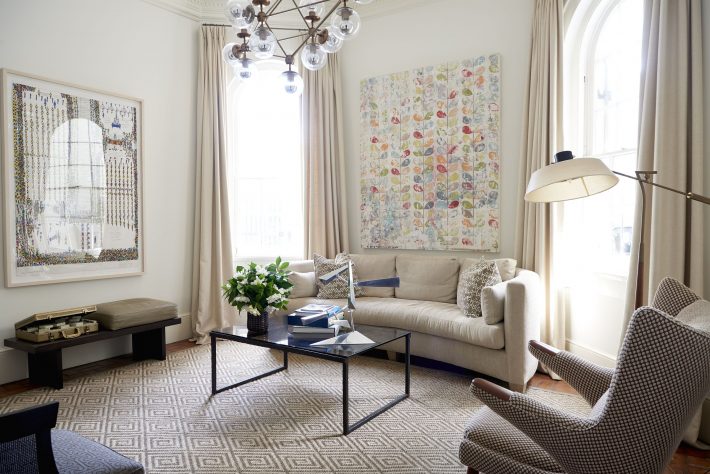
In the living room, Arthur Roger found a curved sofa to fit the rounded walls of the room. The painting over the sofa is by Nicole Charbonnet. The artwork over the bench is by Dapper Bruce Lafitte.
“I knew I wanted to live in the French Quarter, and I looked at properties for a year. My real estate agent suggested I look at one in the level above the price range we had focused on. When he told me the address, and I realized that it was this house, I couldn’t believe it,” Roger says. “I bought it on the spot and then I couldn’t sleep for a month because I’d taken it on.”
That was in 1998, and over the next 19 years he would remodel all four buildings, bringing them closer to their classic look. (The original homestead had been carved up over the years, and the Creole Cottage and garçonnière were not part of the initial purchase. He bought them years later, when they came up for sale, to reunite the original homestead.)

Left: When Roger purchased it, the garçonnière had a dirt floor. He installed a brick floor, mirroring the one in the octagon house. Right: In the Creole Cottage, Roger chose to leave a crumbling wall as is. The portrait is from artist David Bates’ series The Storm, a reaction to Hurricane Katrina. The table was purchased at Jon Vaccari Design and the light fixture is the Model 2097 30 chandelier from Design Within Reach.
“When I bought the properties the buildings were in good shape, but they were trying to be more modern,” Roger says. “I’ve tried to simplify the structures, while retaining their funkiness.”
That “funkiness” has been present since the homes’ inception. According to Roger, the structures were built around 1860 by a French physician who came to the area to treat an outbreak of yellow fever. “Because the house is set back from the street, at first I assumed it had been a brothel,” he says. “But after doing research, I learned that was not the case.” What he has not been able to discover is exactly why the doctor decided to build in an unusual geometry.
An octagon house is, obviously, a structure with eight sides. Inside, the rooms are sliced up like a pie, with a staircase at the center. The house retains its original moldings, doors, and many fixtures, with just a few tweaks. “In the main house, I eliminated some headers and interior shutters, but made all the changes in a way that’s sensitive to the home,” Roger says. He and his partner live in the octagon house, and the rest of the buildings are used as guest houses.

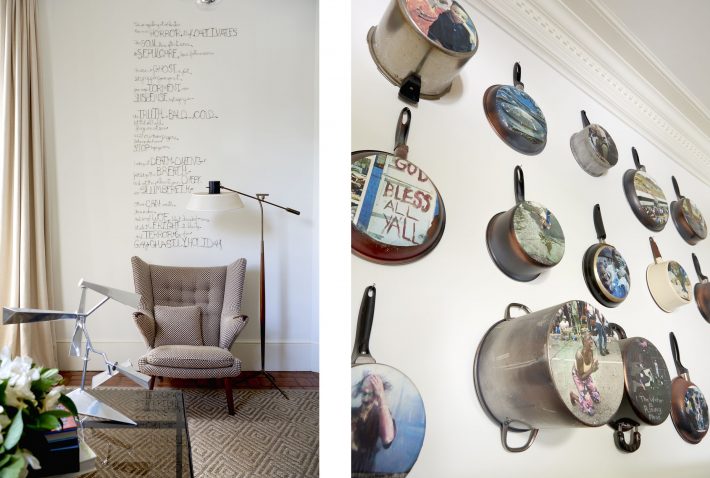
Clockwise from top left: A piece by Radcliffe Bailey deals with a search for identity and features a photograph of the artist’s grandmother surrounded by patterns resembling quilt blocks; the stairwell was home to many artworks; Louisiana artist Luis Cruz Azaceta applied news media images of Hurricane Katrina’s aftermath to a series of pots and pans that had been thrown out after the storm; wire is bent into poetry by artist Lesley Dill and hangs above a Hans Wegner Papa Bear Chair.
Decorating a wedge-shaped room has its challenges. “Introducing a painting or a sofa is a problem,” Roger says. “You hang a picture on one wall, and the other side seems to shout, ‘what about me?’ It becomes something of a Rubik’s Cube.”
What he did have in his favor is the wealth of artisans and craftspeople in the area. “As I began working on the house, I quickly discovered that the trades are very compartmentalized. For instance, when I started restoring the staircase, I found that there’s a person who does handrails, another person who does the spindles, and another who works on the treads. At first I thought it was a racket, but I came to see that that level of specialization can be beneficial in terms of quality.”
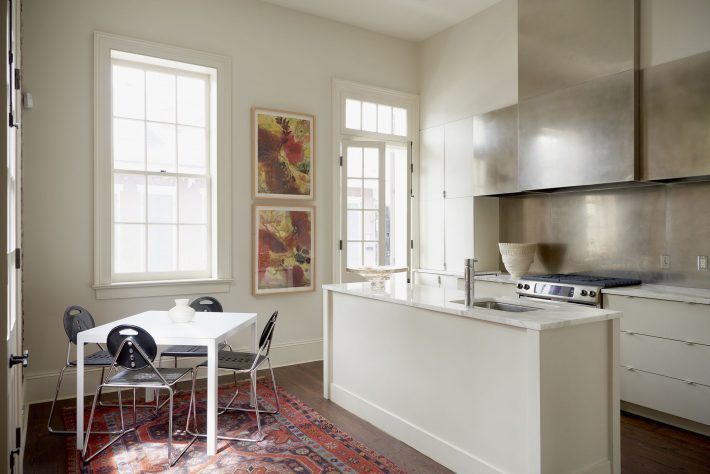
The kitchen in the Creole Cottage illustrates Arthur Roger’s philosophy of quiet backgrounds that let the art shine. Here, works by Allison Stewart stand out against a white background. The custom metal backsplash and ventilation hood are a quiet accent.
At the recommendation of interior designer John Chrestia, he made the backgrounds quiet. In each structure, rooms were done in pale shades and outfitted with neutral furniture, the better to let the art shine. “The art is so dynamic, it made perfect sense,” Roger says.
That said, what he wanted to avoid is living in a gallery or a museum. “The thing about a house like this is that you want to live a bit in the past and a bit in your time. You want to honor the history of the house, while adding your own stamp and hope it’s worthy of that history,” Roger says. “I want this place to feel comfortable, a place where you can relax and not be afraid to have a good time around engaging art.”

A painting of Superman by Nicole Charbonnet used to hang above a bed in a guest room. The She Chair by Alan Siegel glows in the room still.
But now, his collection has a new home at the New Orleans Museum of Art (NOMA), where it’s on view until September 3 in an exhibition called: Pride of Place: The Making of Contemporary Art in New Orleans. The collection contains works that deal with topics ranging from racism, sexual identity, climate change, and other environmental issues. “A lot of the works look at how a specific group of people react to their times,” Roger says. “They deal with things in a way that causes you to open your eyes a little wider and think a bit differently.”
Now that those powerful voices are absent from his home, he may have a bit of empty nest syndrome. “The museum originally approached me about donating the work after I’m dead—but that felt a little weird and creepy,” says Roger. “So, I decided to give them the collection now, while I’m alive. Seeing them hanging in the museum is like having your kids grow up and leave.”
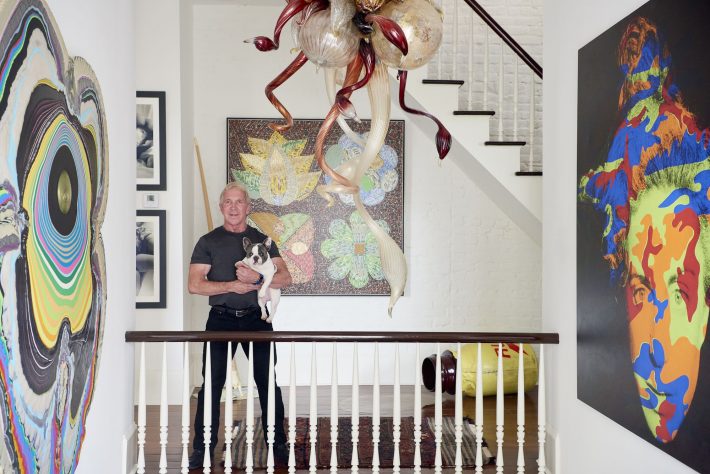
Roger stands on the landing with his dog, Bumble. A chandelier by Dale Chihuly dangles from the ceiling, while works by Troy Dugas using recycled labels hangs on the wall behind him. To the left is a pour painting by Holton Rower and on the right is a work by Deborah Kass.
What to do with all the newly vacated wall space is an open question. “My partner says this is an excuse to buy more, but I don’t think so,” Roger says. “I’m going to live with the bare walls and figure it out one day.”
What hasn’t changed are the buildings themselves and their unique sense of place. “My partner and I talk about how remarkable it is to go up and down these stairs, where many people before us did the same thing,” he says. “I can lie in bed and hear trains, steam boat whistles, street cars, and the drumming in Congo Square—all within one hour,” he says. “It’s one of the best parts of the house, and what makes it feel alive.”
